Locomotives of India
The Indian Railways primarily operates a fleet of electric and diesel locomotives, along with several compressed natural gas (CNG) locomotives. Steam locomotives are operated on a few World Heritage Sites and also run occasionally as heritage trains. A locomotive is also known as a loco or more popularly as an engine. The country's first steam locomotive ran on the Red Hill Railway (built by Arthur Cotton to transport granite for road-building) from Red Hills to the Chintadripet bridge in Madras in 1837.[1]
Classification
Locomotives were classified by track gauge, motive power, function and power (or model number) in a four- or five-letter code. The first letter denotes the track gauge. The second letter denotes motive power (diesel or electric), and the third letter denotes use (goods, passenger, mixed or shunting). The fourth letter denotes a locomotive's chronological model number.
In 2002, a new classification system was adopted. For newer diesel locomotives, the fourth letter denotes their horsepower range. Not all diesel locomotives were reclassified, and the fourth letter continues to denotes their model number.
A locomotive may have a fifth letter, generally denoting a technical variant, subclass or subtype: a variation in the basic model or series, or a different motor or manufacturer. Under the new system, the fifth letter further refines horsepower in 100-hp increments: A for 100 hp, B for 200 hp, C for 300 hp and so on. A WDP-3A is a 3,100 hp (2,300 kW) locomotive, and a WDM-3F is 3,600 hp (2,700 kW).
The system does not apply to steam locomotives, which are no longer used on main lines. They retain their original class names, such as M- or WP-class.
Syntax
- First letter (gauge):
- W – Broad gauge (wide) – 5 ft 6 in (1,676 mm)
- Y – Metre gauge (yard) – 1,000 mm (3 ft 3+3⁄8 in)
- Z – 2 ft 6 in (762 mm) narrow gauge
- N – 2 ft (610 mm) narrow gauge (toy)
- Second letter (motive power):
- D – Diesel
- C – DC electric (DC overhead line)
- A – AC electric (AC overhead line)
- CA – DC and AC (AC or DC overhead line); CA is considered one letter
- B – Battery (rare)
- Third letter (job type):
In WDM 3A, W denotes broad gauge; D denotes diesel power; M denotes mixed use (goods and passenger service), and 3A denotes 3,100 hp (2,300 kW) (3,000 + 100). In WAP 5, W is broad gauge; A is AC electric; P is passenger service, and 5 indicates that the locomotive is the fifth model used.
Broad-gauge (5 ft 6 in) locomotives
Electric
AC electric
Broad-gauge AC electric classification codes are:
- WAM – Wide AC electric mixed
- WAP – Wide AC electric passenger
- WAG – Wide AC electric goods
- WAU – Wide AC electric multiple units''
AC Mixed class (WAM Series)
| Name | Manufacturer | Wheel | Quantity
Built |
Built year(s) | Power | Current Status | Preserved units | Comments | Picture |
|---|---|---|---|---|---|---|---|---|---|
| WAM-1 | KraussMaffei, Krupp, SFAC, La Brugeoise & Nivelle (50 cycles European group) | B-B | 100 | 1959-1960 | 3010 HP | Retired | 1 | First mainline AC electric locomotive | 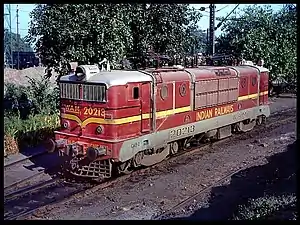 |
| WAM-2 | Mitsubishi | Bo-Bo | 36 | 1960-64 | 2910 HP | Retired | None | ||
| WAM-3 | Mitsubishi | Bo-Bo | 2 | 1964 | 2400 HP | Retired | None | ||
| WAM-4 | CLW | Co-Co | 500 | 1970-1983 | 3850 HP | In service, used in shunting process. | 6 Earmarked | 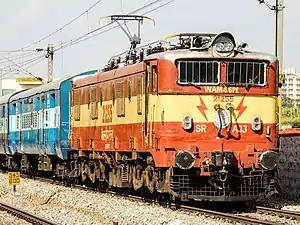 |
AC Passenger class (WAP Series)
| Name | Manufacturer | Wheel
Arr |
Quantity
Built |
Built year(s) | Power | Current Status | Preserved units | Comments | Picture |
|---|---|---|---|---|---|---|---|---|---|
| WAP-1 | CLW | Co-Co | 65 | 1980-1996 | 3900 HP | In service | 1 Earmarked | Numbers used: 22000 - 22076
Many are being converted to WAP-4 |
 |
| WAP-2 | Mitsubishi | Bo-Bo | 2 or 3, all rebuilt from WAM-2 | 1960–1964 | 2910 HP | Retired | None | ||
| WAP-3 | CLW | Co-Co | 9, all rebuilt from WAP-1 | 1987-1988 | 3900 HP | Retired/ In service as WAP-1 | None | ||
| WAP-4 | CLW | Co-Co | 778 | 1993-2015 | 5350 HP | In service | Numbers used: 22201-22399, 22500-22999 & 25000-25051 |  | |
| WAP-5 | ABB / CLW | Bo-Bo | 239 | 1995–Present | 6120 HP | In service | Numbers used: 30000-30200 & 35001+ | 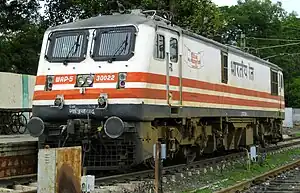 | |
| WAP-6 | CLW | Co-Co | 17 | 1995-1998 | 5350 HP | Retired/ In service as WAP-4 | _at_Khalor%252C_West_Bengal.jpg.webp) | ||
| WAP-7 | CLW/BLW/PLW | Co-Co | 1486 | 2000– present | 6350 HP | In service | The most commonly used passenger locomotive. Numbers used: 30201+, 37001+ and 39000+ |  |
AC Goods class (WAG Series)
| Name | Manufacturer | Wheel
Arrangement |
Quantity
Built |
Built year(s) | H.Power | Current Status | Preserve | Picture |
|---|---|---|---|---|---|---|---|---|
| WAG-1 | Niv./SFAC/ | B-B | 112 | 1963-1966 | 2930 HP | Retired | 1 unit | 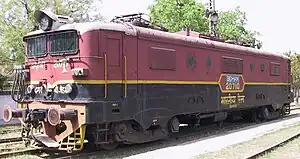 |
| WAG-2 | Hitachi /Toshiba /Mitsubishi | B-B | 45 | 1964-1965 | 3450 HP | Retired | None | 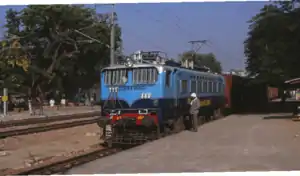 |
| WAG-3 | Henschel/CLW | B-B | 10 | 1965 | 3300 HP | Retired | None |  |
| WAG-4 | CLW | B-B | 186 | 1967-1969 | 3590 HP | Retired | None |  |
| WAG-5 | CLW/BHEL | Co-Co | 1196 | 1978-1998 | 4360 HP | In service | 1 unit | 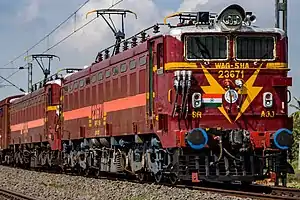 |
| WAG-6A | ASEA | Bo-Bo-Bo | 6 | 1988-1989 | 6110 HP | Retired | 1 unit |  |
| WAG-6B | Hitachi | Bo-Bo-Bo | 6 | 1988 | 6110 HP | In Service | 1 unit |  |
| WAG-6C | Hitachi | Co-Co | 6 | 1988 | 6110 HP | In service | 1 unit |  |
| WAG-7 | CLW/BHEL | Co-Co | 1970 | 1990-2015 | 5350 HP | In service | 1 unit earmarked | 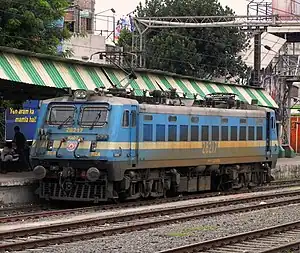 |
| WAG-8 | BHEL | Co-Co | 1 | 1990 | 5000 HP | Retired/ Never went into service | None | |
| WAG-9 | ABB / CLW/BHEL/BLW/PLW | Co-Co[2] | 4263 | 1996–present | 6125/ 9000 HP | In service | 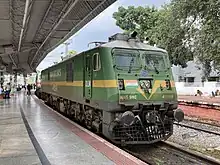 | |
| WAG-10 | BLW | Co-Co-Co-Co | 1 | 2018–present | 10000 HP | In service | 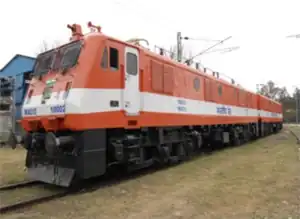 | |
| WAG-11 | BLW | Co-Co-Co-Co/Co-Co | 4 | 2018–present | 12000 HP | Undergoing Trials | 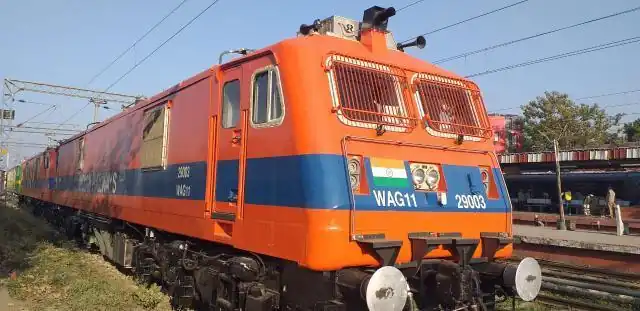 | |
| WAG-12 | Alstom | Bo-Bo-Bo-Bo | 330 | 2017–present | 12000 HP | In service | 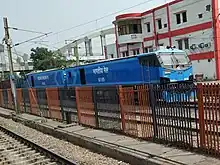 |
AC electric multiple unit (WAU series)
- Electric multiple units are designated WAU-1 to WAU-4.
DC electric
These locomotives, no longer in use, were used only in and around Mumbai with 1.5 kV DC power. All sections of Central Railway, including Thane to Mumbai CST (Main Line), Nerul to Thane (Trans-Harbour Line), Vadala Road to Mahim (Harbour Line, connecting Central and Western Railway) and Panvel to Mumbai CST (Harbour Line) have been converted to 25 kV AC.
Broad-gauge DC electric classification codes are:
- WCM – Wide DC electric mixed
- WCP – Wide DC electric passenger
- WCG – Wide DC electric goods
- WCU – Wide DC electric multiple unit
DC Mixed class (WCM Series)
| Name | Manufacturer | Wheel
Arr |
Quantity
Built |
Built year(s) | Power | Current Status | Preserved units | Comments | Picture |
|---|---|---|---|---|---|---|---|---|---|
| WCM-1 | English Electric / Vulcan Foundry | Co-Co | 7 | 1954-1955 | 3700 HP | Retired | 1 | India's first electric Co-Co locomotive | 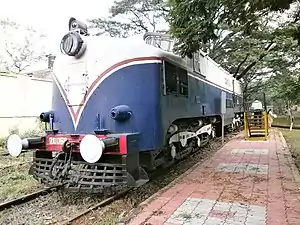 |
| WCM-2 | English Electric / Vulcan Foundry | Co-Co | 12 | 1956-1957 | 3120 HP | Retired | None | 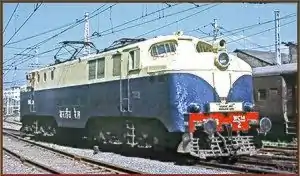 | |
| WCM-3 | Hitachi | Co-Co | 3 | 1958 | 3600 HP | Retired | None | 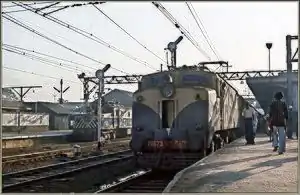 | |
| WCM-4 | Hitachi | Co-Co | 7 | 1960 | 4000 HP | Retired | None | 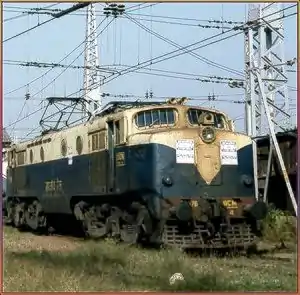 | |
| WCM-5 | CLW | Co-Co | 21 | 1961-1963 | 3700 HP | Retired | 1 unit | 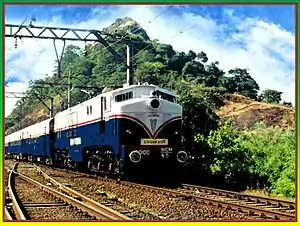 | |
| WCM-6 | CLW | Co-Co | 2 | 1995 | 5000 HP | In service | Converted to 25 kV AC operation | 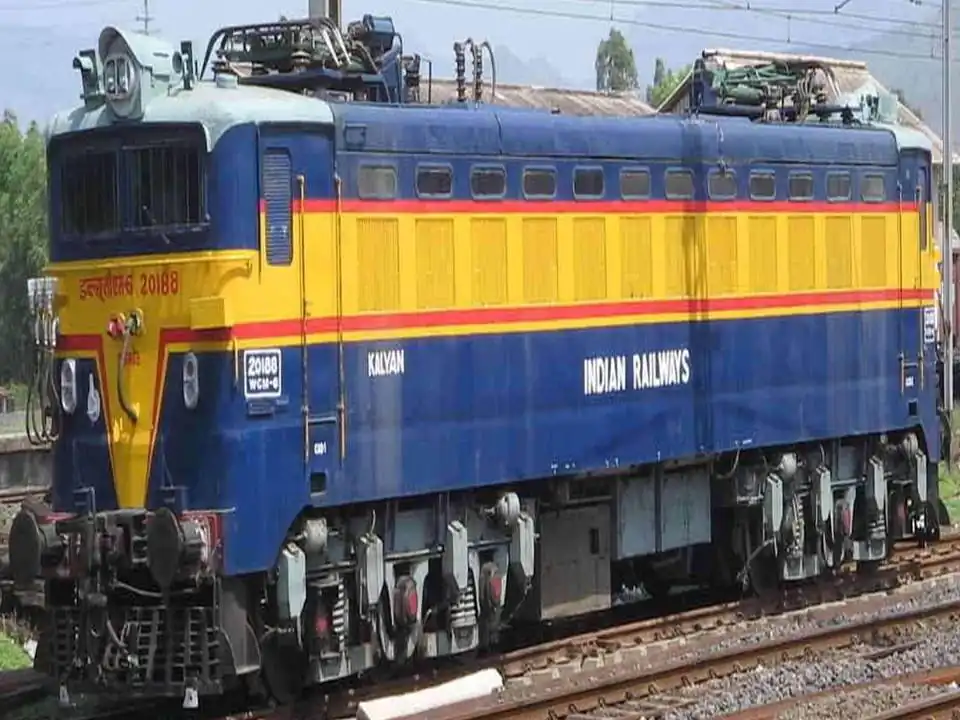 |
DC Passenger class (WCP Series)
| Name | Manufacturer | Wheel
Arr |
Quantity
Built |
Built year(s) | Power | Current Status | Preserved units | Comments | Picture |
|---|---|---|---|---|---|---|---|---|---|
| WCP-1 | SLM / | 2-Bo-A1 | 22 | 1928-30 | 2160 HP | Retired | 1 unit | First electric locomotive of India |  |
| WCP-2 | SLM / | 2-Bo-A1 | 1 | 1938 | 2160 HP | Retired | 1 unit |  | |
| WCP-3 | Hawthorn Leslie, Marconi Company | 2-Co-2 | 1 | 1928 | 2250 HP | Retired | None | 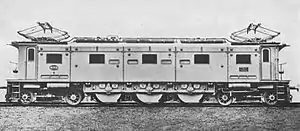 | |
| WCP-4 | Hawthorn Leslie, BBC | 2-Co-2 | 1 | 1928 | 2390 HP | Retired | None |  |
DC Goods class (WCG series)
| Name | Manufacturer | Wheel
Arr |
Quantity
Built |
Built year(s) | Power | Current Status | Preserved units | Comments | Picture |
|---|---|---|---|---|---|---|---|---|---|
| WCG-1 | SLM / | C+C | 41 | 1928-1929 | 2600-2890 HP | Retired | 2 units | 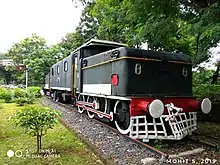 | |
| WCG-2 | SLM / | Co-Co | 57 | 1970-1976 | 4200 HP | Retired | 2 units | 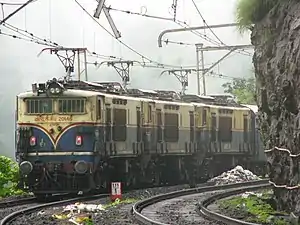 |
DC electric multiple unit (WCU series)
WCU 1 to WCU 15 electric multiple units (EMU) were used in the Mumbai region.
Dual (DC and AC)
Broad-gauge DC and AC electric classification codes are:
- WCAM – Wide DC and AC electric mixed
- WCAG – Wide DC and AC electric goods
Dual Current Mixed class (WCAM Series)
These locomotives are used only in the Mumbai area. They were built to prevent the need to change locos. Mixed locomotives are:
| Name | Manufacturer | Wheel | Quantity
Built |
Built year(s) | Power | Current Status | Comments | Picture |
|---|---|---|---|---|---|---|---|---|
| WCAM-1 | CLW | Co-Co | 54 | 1975-1979 |
|
Retired | First mainline with AC/DC electric locomotive and the only Indian electric loco with reversed pantographs | _Gujarat_Express.jpg.webp) |
| WCAM-2 | BHEL | Co-Co | 20 | 1995-1996 |
|
In service | 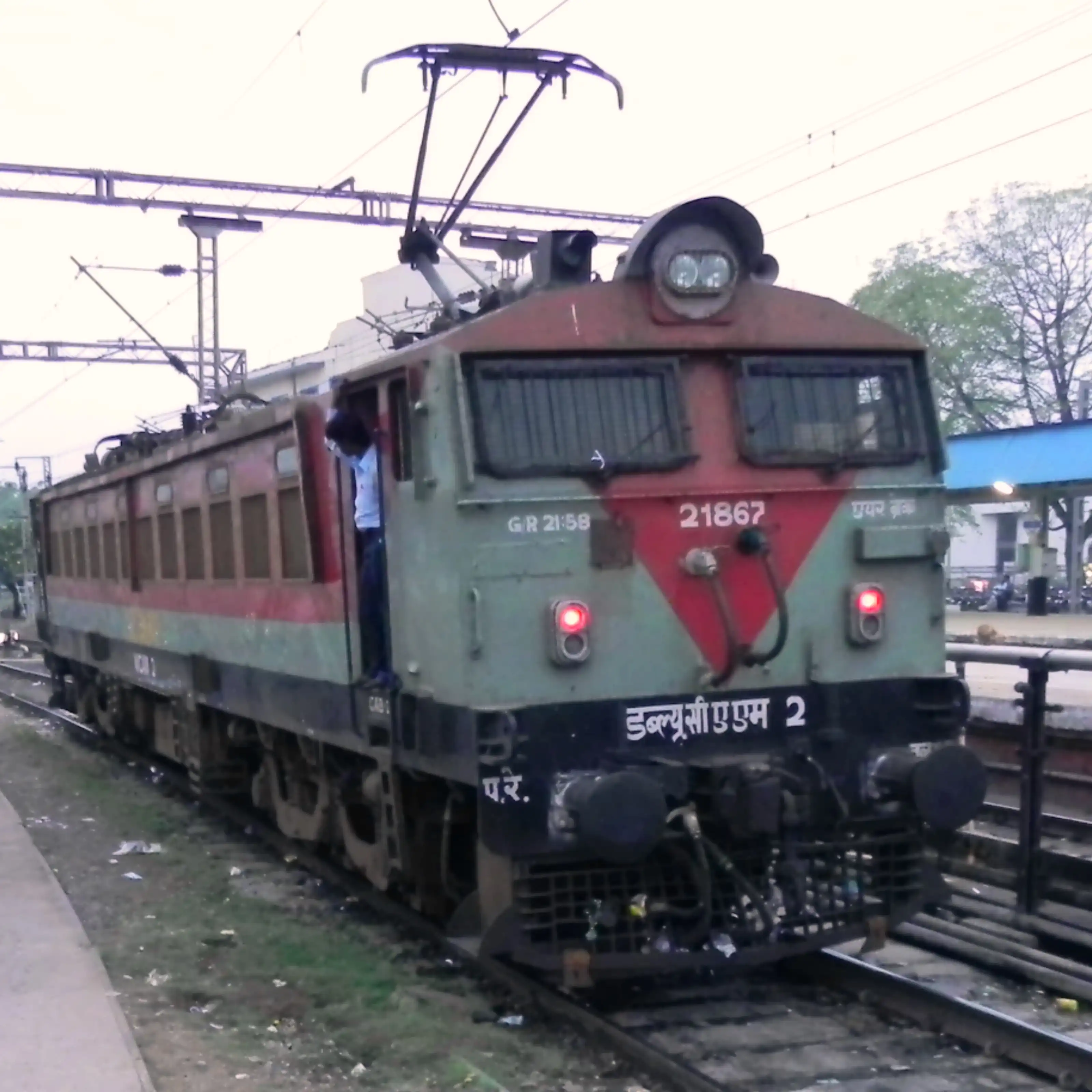 | |
| WCAM-3 | BHEL | Co-Co | 53 | 1997-1998 |
|
In service. | Specifically designed for use by Central Railways in the Ghat section towards Nashik and Pune. Converted To Run On 25kv AC And Renamed As WAG-7M | 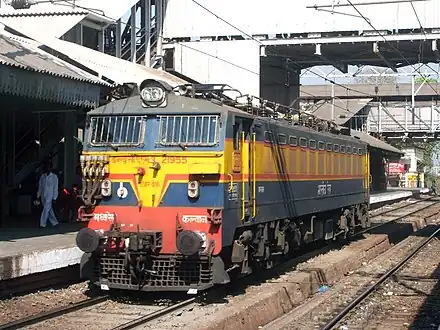 |
Dual Current Goods class (WCAG Series)
| Name | Manufacturer | Wheel | Quantity
Built |
Built year(s) | Power | Current Status | Comments | Picture |
|---|---|---|---|---|---|---|---|---|
| WCAG-1 | BHEL | Co-Co | 12 | 1999-2000 |
|
In service | The only class of the WCAG series |
Battery
Broad-gauge battery classification code is:
- WBCS – Wide battery DC electric shunter
- WCAS – Wide DC(Battery) AC Shunter[3]
Battery shunter class (WBCS series)
In 1927, English Electric and WBC built two shunters for yard use in Bombay with Bo-Bo bogies. They were of the WBCS class. Rated at 240 hp (180 kW), they weighed 58 tons. These are now preserved in National Rail Museum in Delhi. They were charged using the 1500 V DC OHE which was available there.[4]
Battery shunter class (WCAS series)
The locomotives are classified as WCAS. Where W means Wide Gauge, C means DC(Battery), A means AC power, S means Shunting.
Dual-mode
Broad-gauge diesel and electric classification code is:
- WDAP – Wide Diesel and AC electric passenger
Dual mode passenger (WDAP series)
These locomotives are used on routes that can run on both electrified and non-electrified tracks. Their main purpose is to prevent the need of engine change in electrified routes. Passenger locomotives are:
| Name | Manufacturer | Wheel Arrg | Quantity Built | Built year(s) | Power | Current Status | Comments | Picture |
|---|---|---|---|---|---|---|---|---|
| WDAP-5 | BLW | Co-Co | 1 | 2019–present |
|
Undergoing Trials | India's first and only dual-mode locomotive
Number used: 71000 |
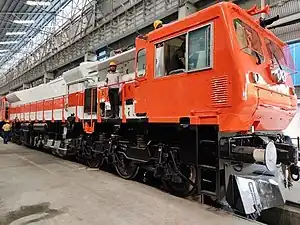 |
Diesel
Broad-gauge diesel classification codes are:
- WDM – Wide diesel mixed
- WDP – Wide diesel passenger
- WDG – Wide diesel goods
- WDS – Wide diesel shunter
- WCDS – Wide converted diesel shunter
- DEMU – Diesel electric multiple unit
- DHMU – Diesel Hydraulic multiple unit
Mixed class (WDM Series)
| Name | Manufacturer | Wheel | Quantity
Built |
Built year(s) | Power | Current Status | Preserved units | Comments | Picture |
|---|---|---|---|---|---|---|---|---|---|
| WDM-1 | ALCO | Co-Co | 100 | 1957-1959 | 1950 HP | Retired | 1 | First mainline diesel locomotive | 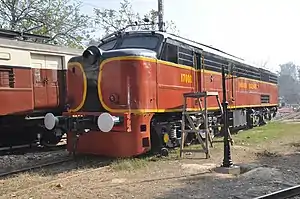 |
| WDM-2 | ALCO/ BLW | Co-Co | 2700 | 1962–1998 | 2600 HP | In service | 9 | A few still in service | 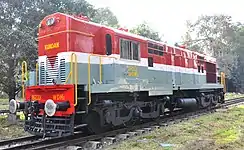 |
| WDM-2G | BLW | Co-Co | 2 | 2013 | 2400 HP | In Service | One of the rarest locomotives in India with only two units being produced by Patiala Locomotive Works. | ||
| WDM-3 | Henschel | Bo-Bo | 8 | 1970 | 2500 HP | Retired | None |  | |
| WDM-3A | BLW | Co-Co | 1402 | 1994–1998 | 3100 HP | In service | 1 Earmarked | 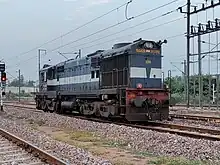 | |
| WDM-3B | BLW | Co-Co | 8, all rebuilt back to WDM-3D | 2005-2006 | 3100 HP | In service | All rebuilt back to WDM-3D | _NR_with_KYQ_-_GIMB_Exp_1.jpg.webp) | |
| WDM-3C | BLW | Co-Co | 10 | 2002 | 3300 HP | In service | None | All rebuilt back to WDM-3A | |
| WDM-3D | BLW | Co-Co | 500 | 2003-2013 | 3300 HP | In service | 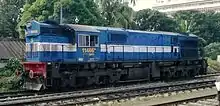 | ||
| WDM-3E | BLW | Co-Co | 8 | 2008 | 3500 HP | In service | |||
| WDM-3F | BLW | Co-Co | 3 | 2008 | 3600 HP | In service | |||
| WDM-4 | GM | Co-Co | 72 | 1962 | 2600 HP | Retired | 2 | 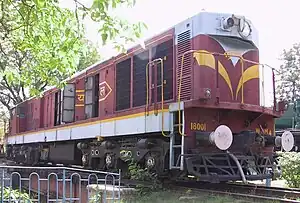 | |
| WDM-6 | BLW | Bo-Bo | 2 | 1981-1982 | 1350 HP | Retired | 2 | Both units earmarked for preservation | 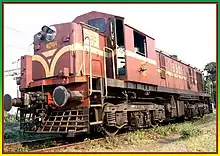 |
| WDM-7 | BLW | Co-Co | 15 | 1987–1989 | 2000 HP | In service | 1 Earmarked | Currently used for shunting uses only | 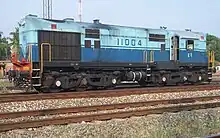 |
Passenger class (WDP Series)
| Name | Manufacturer | Wheel
Arr |
Quantity
Built |
Built year(s) | Power | Current Status | Preserved units | Comments | Picture |
|---|---|---|---|---|---|---|---|---|---|
| WDP-1 | BLW & ALCO | Bo-Bo | 69 | 1995–1999 | 2300 HP | In service | _locomotive_with_Rewari_Passenger.jpg.webp) | ||
| WDP-3A | BLW & ALCO | Co-Co | 44 | 1998–2002 | 3100 HP | In service | 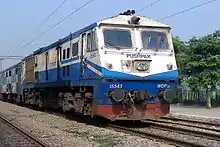 | ||
| WDP-4 | EMD
& BLW |
Bo1-1Bo | 100 | 2002–2011 | 4000 HP | In service | 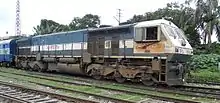 | ||
| WDP-4B | EMD
& BLW |
Co-Co | 86 | 2010–2014 | 4500 HP | In service |  | ||
| WDP-4D | EMD
& BLW |
Co-Co | 525 | 2010–2018 | 4500 HP | In service |  |
Goods class (WDG Series)
| Name | Manufacturer | Wheel
Arr |
Quantity
Built |
Built year(s) | Power | Current Status | Preserved units | Comments | Picture |
|---|---|---|---|---|---|---|---|---|---|
| WDG-3A | BLW | Co-Co | 1998 | 1995–2010 | 3100 HP | In service | 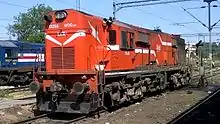 | ||
| WDG-3B | BLW | Co-Co | 4 | 2004 | 3200 HP | In service | |||
| WDG-3C | BLW | Co-Co | 1 | 2001 | 3300 HP | In service | |||
| WDG-3D | BLW | Co-Co | 1 | 2001 | 3400 HP | In service | |||
| WDG-4 | EMD/BLW | Co-Co | 1188 | 1999–2012 | 4500 HP | In service | 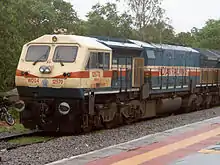 | ||
| WDG-4G | GE | Co-Co | 410 | 2017–present | 4500 HP | In service | .jpg.webp) | ||
| WDG-4D | BLW | Co-Co | 583 | 2013–2018 | 4500 HP | In service | 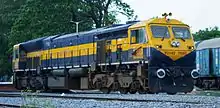 | ||
| WDG-5 | BLW | Co-Co | 7 | 2012-2017 | 5500 HP | In service | .jpg.webp) | ||
| WDG-6G | GE | Co-Co | 62 | 2018–present | 6000 HP | In service |
|
Shunter Class (WDS Series)
| Name | Manufacturer | Wheel
Arr |
Quantity
Built |
Built year(s) | Power | Current Status | Preserved units | Comments | Picture |
|---|---|---|---|---|---|---|---|---|---|
| WDS-1 | GE | Bo-Bo | 15 | 1944-1945 | 386 HP | Retired | 1 | India's first diesel locomotive | 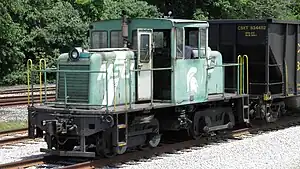 |
| WDS-2 | Kraus
Maffei |
C | 30 | 1954-1955 | 440 HP | Retired | None | .jpg.webp) | |
| WDS-3 | Maschi-
nenbau Kiel |
C | 7 | 1961 | 618 HP | Retired | None | 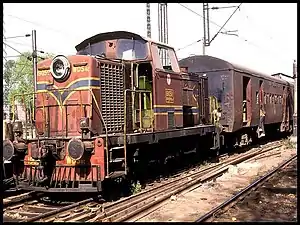 | |
| WDS-4 | CLW | C | 27 | 1968-1969 | 600 HP | Few are still in service | 4 | A few still in service | 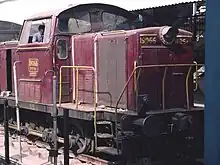 |
| WDS-4A | CLW | C | 5 | 1968 | 660 HP | Retired | 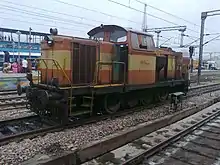 | ||
| WDS-4B | CLW | C | 450 | 1969 | 700 HP | Retired | 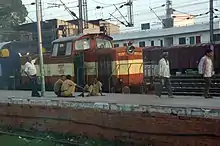 | ||
| WDS-4C | CLW | C | 7 | 1976-78 | 700 HP | Retired |  | ||
| WDS-4D | CLW | C | 120 | 1984-97 | 700 HP | Retired | .jpg.webp) | ||
| WDS-5 | ALCO/BLW | Co-Co | 21 | 1967 | 1065 HP | Retired | None | .jpg.webp) | |
| WDS-6 | BLW | Co-Co | 270 | 1975– | 1400 | In service | 2 Earmarked | ||
| WDS-6AD | BLW | Co-Co | 270 | 1975– | 1400 | In service | 2 Earmarked | ||
| WDS-8 | CLW | Bo-Bo | 5 | 1979-1982 | 800 HP | Retired | None | 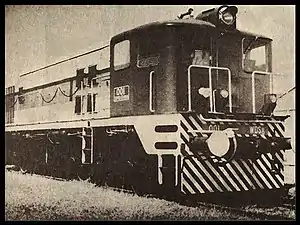 |
Converted shunter class (WCDS series)
The WCDS6, a YDM4 locomotive, was converted to broad gauge by the Golden Rock Railway Workshop for large industrial companies; the first one was delivered to RITES. New water and air lines were added, the control stand was modified, and it has a dual brake system.
Diesel multiple units
A few routes have DMU service. Depending on their transmission system, they are classified as DEMU (diesel-electric transmission) or DHMU (diesel-hydraulic transmission). There is diesel railcar service (known as railbus) in several areas.
Steam
Nineteenth-century railway companies ordered custom-built locomotives, usually from British manufacturers. The multiplicity of similar-but-not-identical designs increased manufacturing cost and slowed production. During the 1890s, many British manufacturers were recovering from work outages, thus Indian railway companies looked to Germany and the United States for locomotives.[5] Engines used were:
- Bengal Nagpur Railway:
- Class F: 0-6-0
- Class GM: 2-6-0 (probably modified)
- BNR class HSG: 2-8-0+0-8-2 Garratt locomotive, India's first successful Garratts
- Class M: 4-6-2 (probably modified)
- BNR class N: 4-8-0+0-8-4 Garratt, India's largest locomotive. One is preserved at the National Rail Museum, New Delhi
- BNR class NM: Similar to N class; ten were built in 1931 by Beyer, Peacock & Company, and it was withdrawn in the late 1960s.
- BNR class P: 4-8-2+2-8-4 Garratt; four were built by Beyer, Peacock & Company in 1939. During the early 1970s, they were at the Bhilai (BIA) shed before being withdrawn.
- Bombay, Baroda & Central India Railway:
- East Indian Railway Company:
- Class CT: 0-6-4T, probably converted to a superheater.
- EIR class G: 2-2-2T. First two named Express and Fairy Queen. Built in 1855, the latter is the world's oldest locomotive to be in working order. Later rebuilt by Perambur Loco Works. Housed at East Indian Railway (EIR)
- EIR class P: 4-6-0
- Great Indian Peninsula Railway:
- GIPR classes Y1, Y2, Y3, and Y4: 0-8-4T. Used on Thal Ghat as bankers for pushing trains up the Western Ghats.
- GIPR Class F and F3: 2-6-0
- GIPR class J1: 0-6-0
- Class D4: 4-6-0; one is named Hero.
- Class D5: 4-6-0 passenger locomotive
- Class E1: 4-4-2 Atlantic built by the North British Locomotive Company in 1907–8. Rebuilt with a superheater between 1925 and 1928.
- Class T: Tank locomotive used for hauling Mumbai suburban trains
- Class Y: 2-8-4T
- Crane tank: 0-6-0T; one is preserved at the National Rail Museum in New Delhi.
- Madras and Southern Mahratta Railway:
- Nizam's Guaranteed State Railway:
- NSR class A: 2-6-0T (No. 48, probably an Atlantic) preserved at the National Rail Museum, Delhi.
- North Western State Railway:
- Class EM: 4-4-2 (probably modified); one is preserved at the National Rail Museum[6]
- NWR class GAS: 2-6-2+2-6-2 Garratt; one built in 1925, and retired in 1937.
- NWR class P: 2-4-0
- Class E1: 4-4-2
- Class N1: 4-8-0
- Oudh and Rohilkhand Railway:
- Class B26: 0-6-0; one is preserved at the National Rail Museum.
- Others:
- Class B: 2-6-0
- Class E: 2-4-0
- Class F: 2-8-2, built between 1926 and 1950 by Nasmyth Wilson for service on Central Railway (CR).
- Class G: 2-6-0, probably intended for freight
- Class NA2
- Class PTC: 2-6-4T, owned by Northern Railway (NR); probably a converted passenger locomotive
- Class Y2: 2-8-2T, reclassified L2
- Phoenix: 0-4-0T; one is at the National Rail Museum.
- Ramgotty: 2-2-0T; the National Rail Museum's oldest locomotive, it was converted to broad gauge.
- Sultan, Sahib and Sindh: Hauled the train from VT to Thana in 1853.
Designs
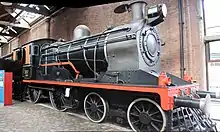
After acrimonious words in The Times and Parliament, the British Engineering Standards Committee (later the British Engineering Standards Association) began designing a series of locomotives for use by Indian railways. The first two designs emerged in 1903: a 4-4-0 passenger and 0-6-0 goods. They were revised in 1905 and 1906 with additional heavier, more-powerful locomotives:
- Class SP: Standard passenger (4-4-0)
- Class SG: Standard goods (0-6-0)
- Class PT: Passenger tank (2-6-4T)
- Class HP: Heavy passenger (4-6-0)
- Class AP: Atlantic passenger (4-4-2)
- Class HG: Heavy goods (2-8-0)
- Class HT: Heavy tank (2-8-2T)
These advisory BESA designs were customized by the railway companies, which used different classification systems; only the state-operated railways used the class designations SP, SG, PT, HP, AP, HG and HT. When superheating was accepted, superheated versions were classified SPS, SGS and so on (if built with superheaters) and SPC, SGC and so on (if converted from saturated to superheated).
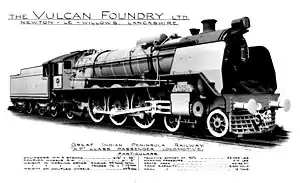
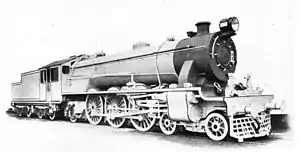
After World War I, larger and more-powerful locomotives were designed by British consulting engineers for the Indian government. They began to appear in 1927:
- Class XA: branch passenger 4-6-2 design, 12.5-ton axle load
- Class XB: light passenger 4-6-2 design, 17-ton axle load
- Class XC: heavy passenger 4-6-2 design, 19.5-ton axle load
- Class XD: Light goods 2-8-2 design, 17-ton axle load
- Class XE: heavy goods 2-8-2 design, 22.5-ton axle load
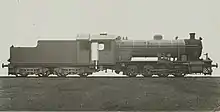
- Class XF: light shunting 0-8-0 design, 18-ton axle load
- Class XG: heavy shunting 0-8-0 design, 23-ton axle load
- Class XH: 4-cylinder 2-8-2, 28-ton axle load; none were built
- Class XP: experimental passenger 4-6-2, 18.5-ton axle load
- Class XS: experimental 4-cylinder 4-6-2, 21.5-ton axle load
- Class XT: light tank 0-4-2T, 15-ton axle load
During World War II, large numbers of 2-8-2 locomotives were acquired from the United States and Canada and classified AWD and CWD. The Baldwin Locomotive Works adapted the USATC S160 Class locomotive design for India, and it became class AWC. Sixty broad-gauge locomotives were built in 1944 as part of an order of 180 S160 engines. In addition to modified frame spreaders, axles, cylinders, and cab, the Indian locomotives had a turbo generator and electric lighting (not included in the standard European design). Many parts (including boilers) were identical to those in standard-gauge locomotives.[7]
Although new classes were designed shortly before the war, many did not enter service until the post-war period. The new classes were indicated by the change of broad-gauge prefix from X to W, and plans were implemented to begin manufacturing locomotives in India. The new classes were:
- Class WP: passenger 4-6-2, 18.50-ton axle load
- Class WG: goods 2-8-2, 18.50-ton axle load
- Class WL (1st): light 4-6-2, 16.00-ton axle load (four for North Western Railway in 1939; all to Pakistan during partition of India)
- Class WL (2nd): light 4-6-2, 16.75-ton axle load
- Class WM: 2-6-4T, 16.25-ton axle load
- Class WT: 2-8-4T, 18.00-ton axle load
- Class WU: 2-4-2T, 16.50-ton axle load
- Class WV: 2-6-2T, 16.25-ton axle load
- Class WW: 0-6-2T, 16.50-ton axle load
All broad-gauge steam locomotives in India have been withdrawn from normal service, with only occasional steam specials continuing to operate.
Metre-gauge (3 ft 3⅜ in) locomotives
Electric
Metre-gauge electric classification codes are:
- YAM – Metre gauge AC electric mixed
- YCG – Metre gauge DC electric goods
- YAU – Metre gauge AC electric multiple units
AC mixed class (YAM Series)
| Name | Manufacturer | Wheel | Quantity
Built |
Built year(s) | Power | Current Status | Preserved units | Comments | Picture |
|---|---|---|---|---|---|---|---|---|---|
| YAM-1 | Mitsubishi | B-B | 20 | 1964-66 | 1740 | Retired | 2 units | Twenty 1,740 hp (1,300 kW) locomotives, imported from Japan, were in service until 2004 in the Chennai area. | 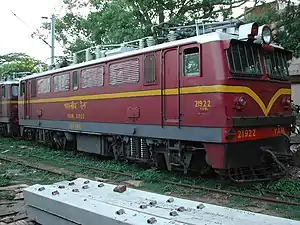 |
DC goods class (YCG series)
| Name | Manufacturer | Wheel | Quantity
Built |
Built year(s) | Power | Current Status | Preserved units | Comments | Picture |
|---|---|---|---|---|---|---|---|---|---|
| YCG-1 | HL / EE | Bo+Bo | 4 | 1930 | 640 | Retired | 2 units | Among India's earliest electric locomotives, the class was imported to serve the Chennai area in the early 1930s | 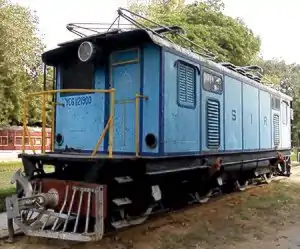 |
AC multiple units (YAU series)
In the Chennai area.[8]
Diesel
Metre-gauge diesel classification code is:
- YDM – Metre gauge diesel mixed
Mixed class (YDM Series)
| Name | Manufacturer | Wheel
Arr |
Quantity
Built |
Built year(s) | Power | Current Status | Preserved units | Comments | Picture |
|---|---|---|---|---|---|---|---|---|---|
| YDM-1 | NBL | B-B | 20 | 1955-56 | 700 | Retired | India's first metre-gauge diesel locomotive |  | |
| YDM-2 | CLW | B-B | 41 | 1986-90 | 700 | Retired | None | 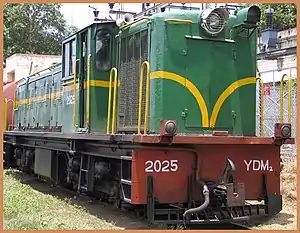 | |
| YDM-3 | GM | B-B | 30 | 1961-62 | 1390 | Retired | 1 unit |  | |
| YDM-4 | ALCO/BLW | Co-Co | 541 | 1961–1993 | 1400 | In service | Many | .JPG.webp) | |
| YDM-5 | GM | C-C | 25 | 1964 | 1390 | Retired | 2 units | 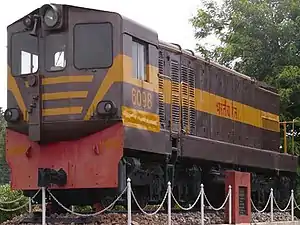 |
Steam
- Nilgiri Mountain Railway X class
- BESA designs:
- Passenger (4-6-0)
- Mixed (4-6-0)
- Goods (4-8-0)
- Tank (2-6-2T)
- Indian Railway Standards designs of the late 1920s
- Class YA: 4-6-2 with 9-ton axle load (none built)
- Class YB: 4-6-2 with 10-ton axle load (161 built for India and 50 for Burma)
- Class YC: 4-6-2 with 12-ton axle load (15 built for India and 13 for Burma)
- Class YD: 2-8-2 with 10-ton axle load (171 built for India, 61 for Burma, and 25 for East Pakistan)
- Class YE: 2-8-2 with 12-ton axle load (none built)
- Class YF: 0-6-2 with 8-ton axle load; later examples were 2-6-2 (111 built for India)
- Class YK: 2-6-0 version of the 2-6-2 YF, 8-ton axle load (25 built for India)
- Class YT: 0-4-2T with 8-ton axle load (2 built for India)
- Wartime designs:
- Class MAWD: 2-8-2 USATC S118 Class
- Class MWGX: 4-6-2+2-6-4 Garratt
- Indian Railway Standards post war designs
- Class YL: 2-6-2 mixed traffic locomotive with 8-ton axle load (264 built 1953–1957)
- Class YG: 2-8-2 goods locomotive with 101⁄2-ton axle load (1074 built 1949–1972)
- Class YP: 4-6-2 passenger locomotive with 101⁄2-ton axle load (871 built 1949–1970)
- Class YM 2-6-4T with 9-ton axle load (12 built 1956)
Narrow-gauge (2 ft 6 in and 2 ft) locomotives
Diesel
Narrow-gauge diesel classification codes are:
- ZDM – Narrow gauge 2 ft 6 in diesel mixed
- NDM – Narrow gauge 2 ft diesel mixed
Mixed class (ZDM series)
| Name | Manufacturer | Wheel
Arr |
Quantity
Built |
Built year(s) | Power | Current Status | Preserved units | Comments | Picture |
|---|---|---|---|---|---|---|---|---|---|
| ZDM-1 | Arn. Jung | B+B | 5 | 1955 | 290 | Retired | |||
| ZDM-2 | Maschi-nenbau Kiel | B-B | 25 | 1964-65 | 700 | Retired |  | ||
| ZDM-3 | CLW | B-B | 40 | 1970-82 | 700 | In service | 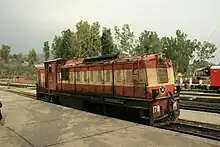 | ||
| ZDM-4/4A | CLW | 1-B-B-1 | 10/39 | 1975-77/1982-90 | 700 | In service | 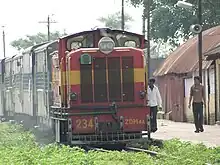 | ||
| ZDM-5 | CLW | B-B | 41 | 1989+ | 450 | In service |  |
Mixed class (NDM series)
| Name | Manufacturer | Wheel
Arr |
Quantity
Built |
Built year(s) | Power | Current Status | Preserved units | Comments | Picture |
|---|---|---|---|---|---|---|---|---|---|
| NDM-1 | Arn. Jung | B+B | 7 | 1955 | 290 | In service | 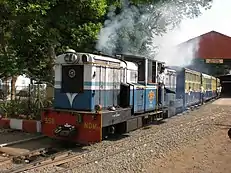 | ||
| NDM-5 | CLW | B-B | 11 | 1987-89 | 450 | In service |
| ||
| NDM-6 | (SAN) Engg. and Loco Co. | B | 6 | 1997 | 335 | In service |
|
2 ft 6 in
- Barsi Light Railway:
- Class A: 0-8-4T
- Class B: 4-8-4T
- Class C: 0-6-0ST
- Class D: 0-4-0
- Class E: Sentinel railcars
- Class F: 2-8-2
- Class G: 4-6-4
- Indian Railway Standards:
- Class ZA: 2-6-2 with 4.5-ton axle load (none built)
- Class ZB: 2-6-2 with 6-ton axle load
- Class ZC: 2-8-2 with 6-ton axle load (none built)
- Class ZD: 4-6-2 with 8-ton axle load (none built)
- Class ZE: 2-8-2 with 8-ton axle load
- Class ZF: 2-6-2T with 8-ton axle load
2 ft
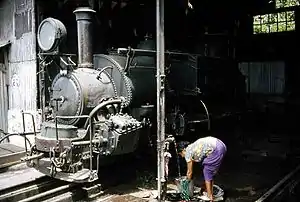
- Darjeeling Himalayan Railway:
- DHR A Class: 0-4-0WT;
- DHR B Class: 0-4-0ST; #777 and #778 preserved
- DHR C Class: 4-6-2
- DHR D Class: 0-4-0+0-4-0 Garratt
- Indian Railway Standards (none built):
- QA: 2-6-2 with 4.5-ton axle load
- QB: 2-6-2 with 6-ton axle load
- QC: 2-8-2 with 6-ton axle load
Battery
Narrow-gauge battery classification code is:
- NBM – Narrow gauge 2 ft battery mixed
Mixed class (NBM series)
- NBM-1: Designed by BHEL in 1987
See also
References
Notes
- "[IRFCA] India's First Railways". irfca.org. Archived from the original on 21 February 2018. Retrieved 9 March 2018.
- "WAG9 Co-Co". Archived from the original on 4 December 2020. Retrieved 6 October 2020.
- "Battery Powered Loco WCAS". Archived from the original on 15 July 2020. Retrieved 11 July 2020.
- "IRFCA". Archived from the original on 27 February 2014. Retrieved 4 January 2014.
- Hughes 1979, p. 17
- "Pakistan Railways steam locomotive | Science Museum Group Collection". collection.sciencemuseumgroup.org.uk. Archived from the original on 26 May 2021. Retrieved 26 May 2021.
- Baldwin Locomotive Works drawing index and bill of materials for special order 43306, locomotive design 2-8-0 19S, numbers 666 to 845 for the U.S. Government, War Department.
- Historic Chennai 9 car Meter Gauge EMU with 3 power cars, archived from the original on 21 December 2021, retrieved 1 June 2021
Bibliography
- Hughes, Hugh (1976). Steam in India. Truro, Cornwall: D. Bradford Barton Ltd. ISBN 0851532586.
- Hughes, Hugh (1979). Steam locomotives in India, Part 3 – Broad Gauge. Harrow, Middlesex: The Continental Railway Circle. ISBN 0-9503469-4-2.
- Hughes, Hugh (1990). Indian Locomotives: Part 1 – Broad Gauge 1851–1940. Harrow, Middlesex: The Continental Railway Circle. ISBN 0-9503469-8-5. OCLC 21871114.
- Hughes, Hugh (1992). Indian Locomotives: Part 2 – Metre Gauge 1872–1940. Harrow, Middlesex: The Continental Railway Circle. ISBN 0-9503469-9-3. OCLC 26549293.
- Hughes, Hugh (1994). Indian Locomotives: Part 3 – Narrow Gauge 1863–1940. Harrow, Middlesex: The Continental Railway Circle. ISBN 0-9521655-0-3. OCLC 39496543.
- Hughes, Hugh (1996). Indian Locomotives: Part 4 – 1941–1990. Harrow, Middlesex: The Continental Railway Circle. ISBN 0-9521655-1-1. OCLC 35135033.
- Marshall, Lawrence G (2001). Indian Narrow Gauge Steam Remembered. East Harling, Norfolk: Plateway Press. ISBN 1871980488.
- Marshall, Lawrence G (2005). Indian Metre Gauge Steam Remembered. East Harling, Norfolk: Plateway Press. ISBN 1871980542.
- Marshall, Lawrence G (2009). Indian Broad Gauge Steam Remembered. East Harling, Norfolk: Taverner Publications. ISBN 9781901470154.
- Woods, George (2017). Indian Steam in the 1970s. Stroud, Glos: Amberley Publishing. ISBN 9781445666785.
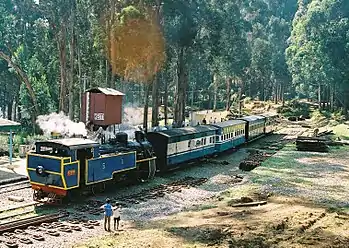
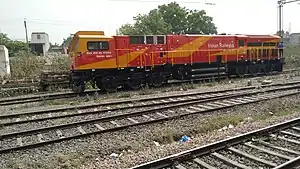
_DHMU_at_Malkajgiri_01.jpg.webp)


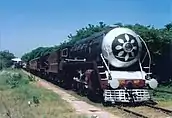
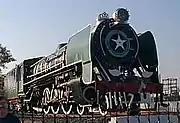
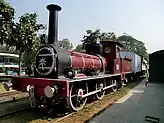
.JPG.webp)
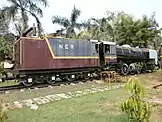


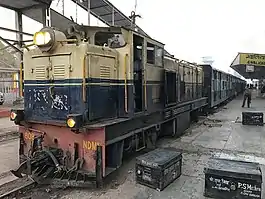
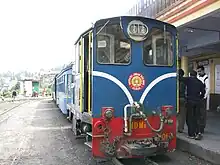


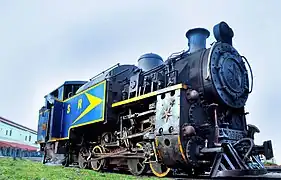

.jpg.webp)